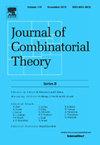关于赛事结构的一些结果和问题
IF 1.2
1区 数学
Q1 MATHEMATICS
引用次数: 0
摘要
本文研究了以下问题的结果和问题:如果G是一个具有足够大色数的锦标赛,那么G是否有两个顶点不相交的子锦标赛a,B,它们都具有较大的色数,并且它们之间的所有边都从a指向B?我们描述了我们对这个问题的了解,并报告了一些其他相关问题的进展,关于比赛的颜色和统治。本文章由计算机程序翻译,如有差异,请以英文原文为准。
Some results and problems on tournament structure
This paper is a survey of results and problems related to the following question: is it true that if G is a tournament with sufficiently large chromatic number, then G has two vertex-disjoint subtournaments , both with large chromatic number, such that all edges between them are directed from A to B? We describe what we know about this question, and report some progress on several other related questions, on tournament colouring and domination.
求助全文
通过发布文献求助,成功后即可免费获取论文全文。
去求助
来源期刊
CiteScore
2.70
自引率
14.30%
发文量
99
审稿时长
6-12 weeks
期刊介绍:
The Journal of Combinatorial Theory publishes original mathematical research dealing with theoretical and physical aspects of the study of finite and discrete structures in all branches of science. Series B is concerned primarily with graph theory and matroid theory and is a valuable tool for mathematicians and computer scientists.

 求助内容:
求助内容: 应助结果提醒方式:
应助结果提醒方式:


